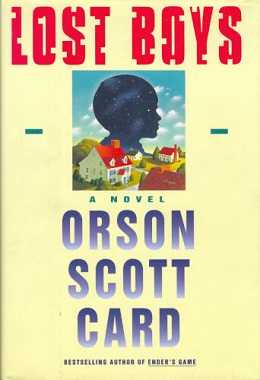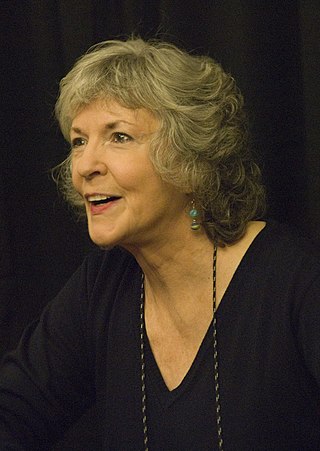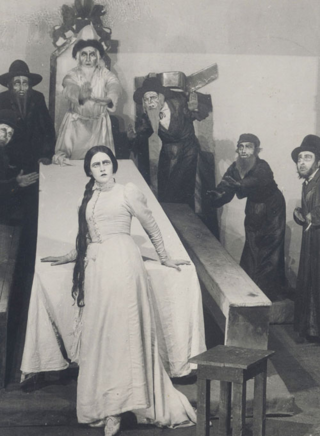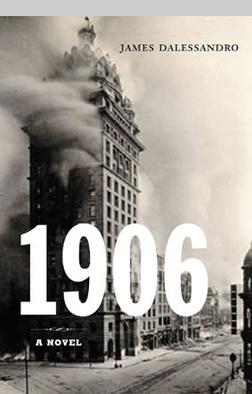
The Judgement of Paris is a story from Greek mythology, which was one of the events that led up to the Trojan War and in later versions of the story to the foundation of Rome.
A first-person narrative is a mode of storytelling in which a storyteller recounts events from that storyteller's own personal point of view, using first-person grammar such as "I", "me", "my", and "myself". It must be narrated by a first-person character, such as a protagonist, re-teller, witness, or peripheral character. Alternatively, in a visual storytelling medium, the first-person perspective is a graphical perspective rendered through a character's visual field, so the camera is "seeing" out of a character's eyes.

Lost Boys (1992) is a horror novel by American author Orson Scott Card. The premise of the novel revolves around the daily lives of a Mormon family, and the challenges they face after a move to North Carolina. The story primarily follows the family's troubles at work, church, and the oldest child Stevie's difficulty fitting in at school, which lead to him becoming increasingly withdrawn.

The A.B.C. Murders is a work of detective fiction by British writer Agatha Christie, featuring her characters Hercule Poirot, Arthur Hastings and Chief Inspector Japp, as they contend with a series of killings by a mysterious murderer known only as "A.B.C.". The book was first published in the UK by the Collins Crime Club on 6 January 1936, sold for seven shillings and sixpence (7/6) while a US edition, published by Dodd, Mead and Company on 14 February of the same year, was priced $2.00.

Sue Taylor Grafton was an American author of detective novels. She is best known as the author of the "alphabet series" featuring private investigator Kinsey Millhone in the fictional city of Santa Teresa, California. The daughter of detective novelist C. W. Grafton, she said the strongest influence on her crime novels was author Ross Macdonald. Before her success with this series, she wrote screenplays for television movies.

Down and Out in the Magic Kingdom is a 2003 science fiction book, the first novel by Canadian author and digital-rights activist Cory Doctorow. Concurrent with its publication by Tor Books, Doctorow released the entire text of the novel under a Creative Commons noncommercial license on his website, allowing the whole text of the book to be freely read and distributed without needing any further permission from him or his publisher.

Rogue Trooper is a science fiction strip in the British comic magazine 2000 AD, created by Gerry Finley-Day and Dave Gibbons in 1981. It portrays the adventures of a "Genetic Infantryman" named Rogue and three uploaded minds mounted on his equipment who search for the Traitor General.
A narrative work beginning in medias res opens in the midst of the plot. Often, exposition is bypassed and filled in gradually, through dialogue, flashbacks or description of past events. For example, Hamlet begins after the death of Hamlet's father. Characters make reference to King Hamlet's death without the plot's first establishment of said fact. Since the play is about Hamlet and the revenge more so than the motivation, Shakespeare uses in medias res to bypass superfluous exposition.

Lady in the Lake is a 1947 American film noir starring Robert Montgomery, Audrey Totter, Lloyd Nolan, Tom Tully, Leon Ames and Jayne Meadows. An adaptation of the 1943 Raymond Chandler murder mystery The Lady in the Lake, the picture was also Montgomery's directorial debut, and last in either capacity for Metro-Goldwyn-Mayer (MGM) after eighteen years with the studio. Montgomery's use of point-of-view cinematography and its failure was blamed for the end of his career at MGM.

The Dybbuk, or Between Two Worlds is a play by S. Ansky, authored between 1913 and 1916. It was originally written in Russian and later translated into Yiddish by Ansky himself. The Dybbuk had its world premiere in that language, performed by the Vilna Troupe at Warsaw in 1920. A Hebrew version was prepared by Hayim Nahman Bialik and staged in Moscow at Habima Theater in 1922.

Clayface is an alias used by several supervillains appearing in American comic books published by DC Comics. Most incarnations of the character possess clay-like bodies and shapeshifting abilities, and all of them are adversaries of the superhero Batman. In 2009, Clayface was ranked as IGN's 73rd-greatest comic book villain of all time.

Guardian is a DC Comics superhero introduced in April 1942 by writer/artist Joe Simon and artist Jack Kirby.
The CYCLADES computer network was a French research network created in the early 1970s. It was one of the pioneering networks experimenting with the concept of packet switching and, unlike the ARPANET, was explicitly designed to facilitate internetworking.
A flashback is an interjected scene that takes the narrative back in time from the current point in the story. Flashbacks are often used to recount events that happened before the story's primary sequence of events to fill in crucial backstory. In the opposite direction, a flashforward reveals events that will occur in the future. Both flashback and flashforward are used to cohere a story, develop a character, or add structure to the narrative. In literature, internal analepsis is a flashback to an earlier point in the narrative; external analepsis is a flashback to a time before the narrative started.

There are a wide range of ways in which people have represented the Trojan War in literature and the arts.

Steven Savile is a British fantasy, horror and thriller writer and editor living in Sweden. His published work includes novels and numerous short stories in magazines and anthologies.

Cross is James Patterson's 12th novel featuring his most famous character, Alex Cross. It was released in 2006. This novel was also released in some markets under the title Alex Cross. This book is followed by Double Cross.
Ilium/Olympos is a series of two science fiction novels by Dan Simmons. The events are set in motion by beings who appear to be ancient Greek gods. Like Simmons' earlier series, the Hyperion Cantos, it is a form of "literary science fiction"; it relies heavily on intertextuality, in this case with Homer and Shakespeare as well as references to Marcel Proust's À la recherche du temps perdu and Vladimir Nabokov's novel Ada or Ardor: A Family Chronicle.

1906 is a 2004 American historical novel written by James Dalessandro. With a 38-page outline and six finished chapters, he pitched it around Hollywood in 1998 for a film by the same name, based upon events surrounding the great San Francisco earthquake and fire of 1906.
The Expanse is a series of science fiction novels by James S. A. Corey, the joint pen name of authors Daniel Abraham and Ty Franck. The first novel, Leviathan Wakes, was nominated for the Hugo Award for Best Novel in 2012. The complete series was nominated for the Hugo Award for Best Series in 2017. It later won, following its second nomination for the same award in 2020.















